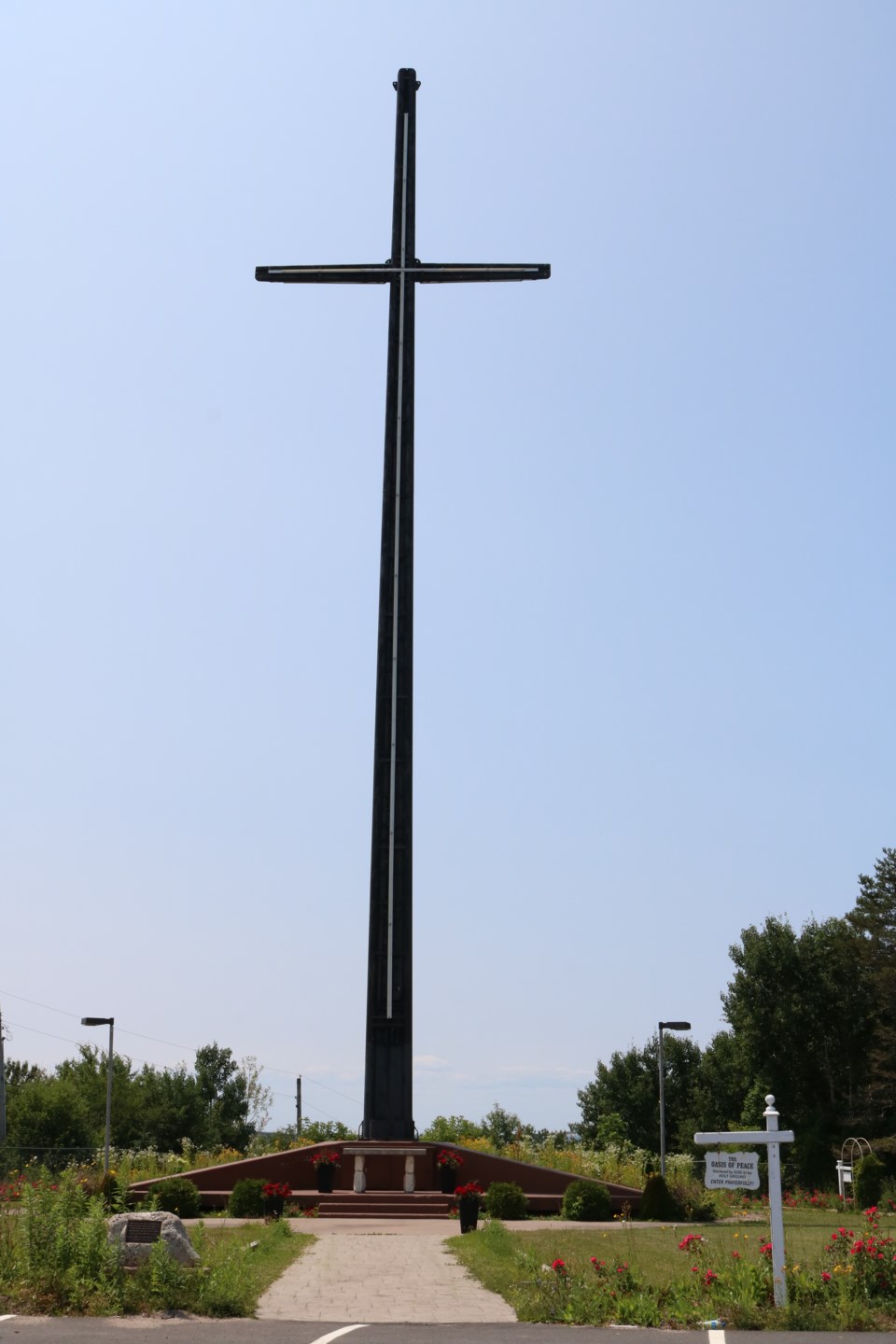From the archives of the Sault Ste. Marie Public Library:
The cross located at the top of St. George’s Avenue is constantly keeping watch over Sault Ste. Marie. When it was built it was to be the highest cross in North America so that it would be clearly visible to all who visited the city.
The historic site of the big cross takes us back to the initial French colonization of the Sault in 1669. The Sault was originally a traditional North American gathering place for the first Anishinaabe people, when the Jesuits, also known as the missionary priests, first gave it the name Sault Ste. Marie, which translates to, "The Rapids of St. Mary".
Louis XIV of France, famously known as the "Sun King", wanted to hold a ceremony in North America and chose the Sault. The festival was held on June 14, 1671 and attended by about 10,000 voyageurs and more than a dozen First Nations tribes — some from as far away as Mexico.
A past Sault Star article indicates that during the ceremony, Saint Lusson claimed North America for the Kingdom of God and the Kingdom of France. The group of voyageurs also pledged to live together in harmony. The cross they erected that day was a sign of this agreement. The wooden cross that was put into place 347 years ago stood for love for each other and the hope that the many different nations of people could live together in peace.
The present cross, located beside the current Notre Dame des Grands Lacs, was the original site of St. Mary's College, which later became Saint Basil. Members of the Sault Ste. Marie St. Mary's College Men's Club began making plans in 1958 to commemorate the 1671 French ceremony by erecting a cross at the site of the Roman Catholic boy's school on Moffley Hill. Two years later, the big cross was officially raised on May 14, 1960.
At the base of the cross is the Oasis of Peace garden which overlooks the St. Marys River. This garden includes about 250 Morden Cardinette Rose hedges, as well as thin slabs of Puddingstone —a Jasper Conglomerate unique to this area with most being found on St. Joseph's Island and in the Bruce Mine's area.
The late Mike Perepelytz first had the idea to place a cross on the hill when he heard of a large cross in Brazil and wanted to have one in the Sault that was 14 feet higher. Mike Lukenda and William Taylor are also credited with having contributed to the creation of the cross.
All the steel and steel tubing used on the project was donated by the Algoma Steel Corporation and the Mannesmann Tube Company. The local community contributed a large portion through volunteers and with money raised through bingo and raffles. The cross was then fabricated by the Imperial Steel Company who also erected the cross.
Broken and burned out bulbs due to vandalism wreaked havoc on the cross shortly after its placement. In 1981, the lighting needed to be repaired for the 100 Huntley Street rally taking place in the Sault, and through donations from the community, the cross was re-lit. The previous lighting had a two-year life, so with repairs, the new acrylic lighting available at the time was considered safe from vandalism. However, vandalism struck soon again and darkened the historic cross for several years before it was lowered on April 11, 1994.
In the process of replacing the fluorescent lighting system with a more effective and economical Halcide Light piping, the cross was sand-blasted, reinforced, welded and repainted. When raised again on Good Friday, April 14, 1995 the cross glowed 70 percent brighter, making it visible from 33 kilometres away.
In the spring of 1990, the Sault Ste. Marie District Roman Catholic Separate School Board concluded an agreement so that the Sault Ste. Marie Association could carry on the preservation of the cross and lease the land on St. George's Avenue, where the cross has remained for the past 58 years.
Written by one of the missionary priests to first visit the Sault, Father Claude Dablon, stated in The Jesuit Relations during the time of the original 17th century cross placement, that; "… When all had been assembled in a great public council, and a height has been chosen well adapted to his purpose, overlooking, as it did, the village of the people of the Sault, —he (Saint Lusson) caused the cross to be planted there, and then the King's standard to be raised, with all the pomp that he could devise."
"The cross was publicly blessed, with all the ceremonies of the church, by the Superior of these Missions, and then, when it has been raised from the ground for the purpose of planting it, the Vexilla Regis was sung."
Each week, the Sault Ste. Marie Public Library and its Archives provides SooToday readers with a glimpse of the city’s past.
Find out more of what the Public Library has to offer at www.ssmpl.ca and look for more Remember This? columns here
